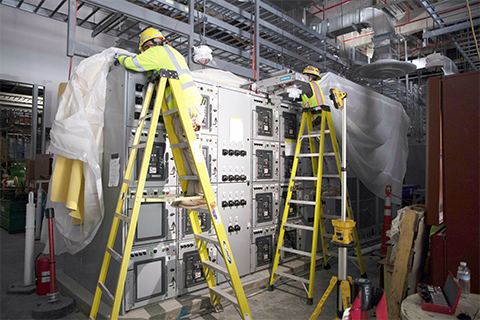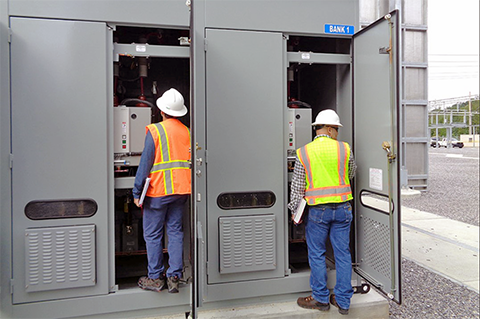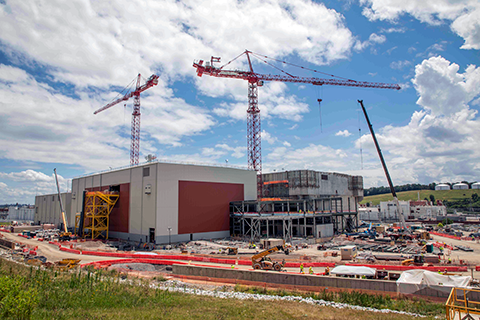The birthplace of the atomic bomb is getting a massive makeover, and an increasing number of IBEW members are on the way to help ensure that this much-needed upgrade is taking place safely and professionally.

|
| Oak Ridge, Tennessee, Local 270 members install a new 13.8kV switchgear for the new Uranium Processing Facility’s Mechanical Electrical Building.
|
Inside eastern Tennessee’s Y-12 National Security Complex, a sister facility to its more widely known neighbor, the Oak Ridge National Laboratory, researchers on the Manhattan Project enriched the uranium used in the atomic bombs deployed over Japan, helping to bring an end to World War II in 1945.
IBEW members were there then, and they’re still there nearly 80 years later, working at Y-12 and continuing to support its mission to prepare and store uranium for installation in modern warheads as well as for use in the reactors that power the U.S. Navy’s nuclear submarines and aircraft carriers. Workers there also safely dismantle decommissioned weaponry and securely stow their nuclear payloads right on the site.
But eight decades can be a long time for any facility, a primary reason why the Department of Energy’s National Nuclear Security Administration broke ground in 2018 on a replacement for the aging Y-12 complex: the multibillion-dollar, state-of-the-art Uranium Processing Facility, or UPF.
Since then, IBEW members in ever-growing ranks have been recruited not just to work on a significant national security project, but also to better understand the important work that’s been happening for decades in the Volunteer State.
“It’s a massive undertaking,” said Tenth District International Vice President Brent Hall. “It says a lot about the IBEW that we’ve been able to staff this job so well.”
By the end of 2021, upwards of 800 journeyman wiremen and apprentices are expected to be in place to help install more than 600 miles of wire and cabling throughout the buildings that make up the new facility.
Oak Ridge Local 270 Business Manager Daniel Smith says his members, who are charged with handling the entirety of the UPF’s electrical construction, are ready for the coming influx of workers who will be working for the project’s contractor, Consolidated Nuclear Security. “Everything’s going in a really good direction,” he said.
A Storied History
By 1943, as America’s involvement in World War II entered its second year, President Franklin D. Roosevelt’s administration had concluded that developing weapons that tapped into the raw power of fission could help end the global conflict that already had killed millions. The War Department selected Oak Ridge for its development site in part because of its relatively easy access to the electricity provided by the various dams and other infrastructure of the Tennessee Valley Authority, another IBEW success story.

|
| Near a substation for the new Uranium Processing Facility, members of Oak Ridge, Tennessee, Local 270 check out a capacitor bank.
|
Enticing electrical workers to come and work in rural Tennessee was a challenge at first. In his book, “Now It Can Be Told,” Army Lt. Gen. Lesley Groves, who oversaw the Manhattan Project, detailed how Robert Patterson, Roosevelt’s undersecretary of war, worked closely with then-IBEW International President Ed J. Brown to come up with a recruitment plan that included transportation benefits and the transfer of seniority rights.
“This plan was a lifesaver,” Groves wrote. “There was an almost complete absence of labor trouble, despite the fact that as many as four crafts were often involved in setting up a single piece of apparatus. To me our excellent labor relations were a great satisfaction.”
Spurred by the urgency of the war effort, these IBEW members worked with the other building trades to get Y-12’s 175 buildings, some as large as football fields, up and running in just 18 months.
This time around, the upgraded UPF is on a somewhat more leisurely schedule, albeit just as strict: a seven-year trajectory that’s targeted for completion by 2025.
Preparing for the Future
Smith said about a fifth of the IBEW workforce getting the job done at the UPF is, and should continue to be, apprentices.
“The project’s working with us on rotating them in,” he said. “It’s great for the contractor and great experience for our apprentices.”
As in the 1940s, these electrical workers are joining nearly 2,000 union brothers and sisters from other building trades who are also working on the UPF.
That size of a union presence is significant, Hall said, because organizing workers remains a challenge in Tennessee. It’s been that way since 1947 when Tennessee became one of the first to adopt a “right-to-work” law after the passage of the Taft-Hartley Act made targeting unions and union members the law of the land.
Still, a handful of unions including the IBEW represent workers at Y-12 and the UPF, including electricians from nearby Knoxville Local 760, who will continue to handle maintenance tasks at both facilities, Hall said. Upon completion of the UPF, the Y-12 facility is set to be fully decommissioned by the mid-2030s.
“A nonunion workforce is out there” to pull from, Hall said. “The UPF might not be your typical construction site, but like any other IBEW job, it still pays well and has attractive benefits.” Another plus to having workers fairly negotiate their union wages, he said, is how their hard-earned money has flowed through to support the Oak Ridge area’s businesses for decades.
No matter what, considering how UPF’s need for electrical workers could wind up nearly tripling the size of Local 270’s membership, “It’s going to be a great opportunity for the local to be organizing,” Hall said.
Construction on the UPF has continued uninterrupted since 2018, even as lockdowns took place around the world to help stop the spread of the COVID-19 pandemic, Smith said. Both the workers and the work itself were considered essential to national security.
“Much of the structure work is complete,” he said. “But there’s a bunch of electrical work still to be done.” Local 270’s electricians already have helped bring online several of the UPF’s infrastructure pieces, but remaining projects, including buildings for processing, salvaging and mechanical/electrical, remain fully on track for completion by 2025.
The men and women of Local 270 who are building at the UPF site take their jobs extremely seriously, Smith said. “They fully understand that the high-security environment requires a major commitment.”
The Department of Energy’s stringent security requirements remain a consideration as well. “It can take months of rigorous background checks that often involve the FBI before our members can gain access inside with all the secret stuff,” Smith said, including workers who might have direct access to nuclear materials at some point. Everyone working at Y-12 and UPF goes through some sort of background check, he said, with the depth of the investigations dependent on where the work can take them.

|
| A contractor handling construction of the new Uranium Processing Facility near Oak Ridge, Tennessee, and impressed with the IBEW’s work there, has asked our union to declare it a Code of Excellence job and to prepare a Code training program for the UPF’s workforce.
|
“Working in nuclear is still serious business and potentially hazardous,” he said. The Department of Energy continuously monitors workers’ exposure to radiation, including daily inspections, regular safety stand-downs and worker-driven safety initiatives. “For them and for us, safety is paramount,” Smith said. “It’s very intensive.”
And while Y-12 remains as safe and secure as it was when it was first commissioned, Hall said, the UPF is going to be “a whole lot safer for our workers and the public.” Plus, the project is taking advantage of the efficiencies developed over the last 80 years. “The new main building is maybe a quarter of the size of the building it’s replacing,” Hall estimates.
Consolidated National Security has been impressed with the work that the IBEW has been putting in at the UPF, Smith said. “They’ve even asked us to make it a Code of Excellence job,” he said, with work underway to come up with a Code training program for the UPF’s workforce.
Hall is not too surprised by this recent development. “Word’s been getting out about the Code in Tennessee. It’s a valuable tool for the IBEW and for our contractors to use to let our customers know that they will be satisfied with our results,” he said.